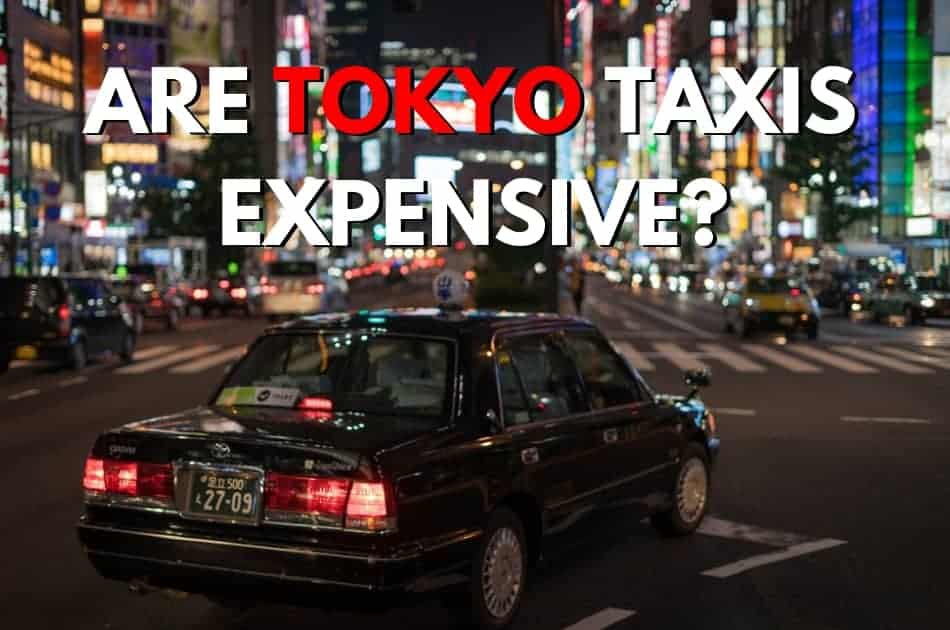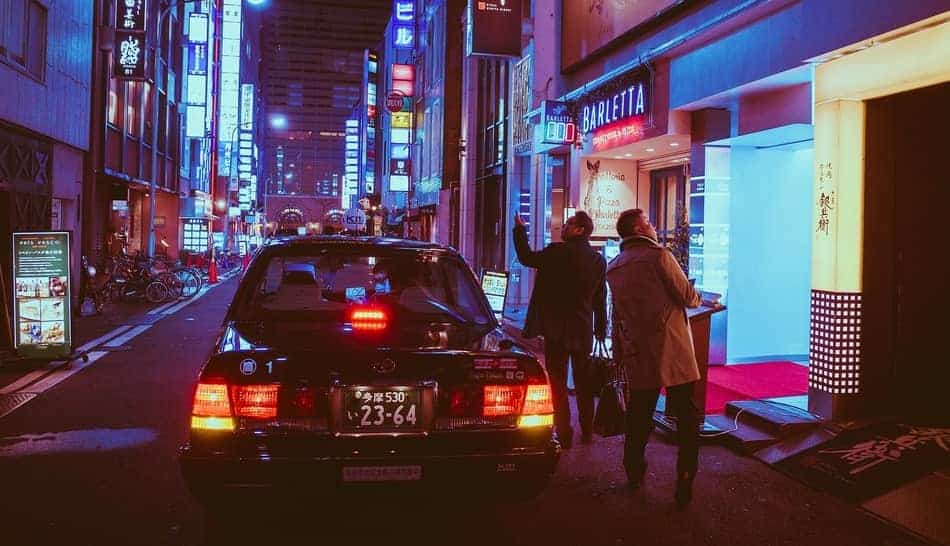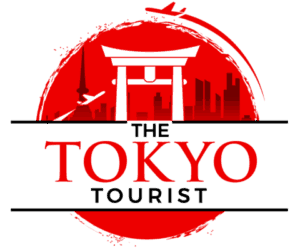Deprecated: mb_convert_encoding(): Handling HTML entities via mbstring is deprecated; use htmlspecialchars, htmlentities, or mb_encode_numericentity/mb_decode_numericentity instead in /home2/thetoky7/public_html/wp-content/themes/acabado/functions.php on line 2119

You want to see as much of Japan as you can on your trip, which means you can’t do all your traveling by foot. As you navigate through Tokyo, you figure one of the easiest ways to get around is via taxi. Before you go, you have to know: are Tokyo taxis expensive?
Tokyo taxis are generally not very expensive, but of course, this all depends on how far you travel. In a four-person vehicle, if you were going only a mile and a half, you’d pay between ¥400 to ¥700. This is the USD equivalent of $3.60 to $6.29. If you needed to go further, per 300 or 400 meters, the fee would increase by ¥80 to ¥90. That’s less than $1.
You may have more questions still about transportation in Tokyo. What drives up taxi costs? Could you ride an Uber or Lyft instead? In this article, I’ll fill you on how much you can expect to pay to get around Tokyo.
Are Tokyo Taxis Expensive?
As mentioned in the intro, while Tokyo taxis are not very expensive, this can change based on how far you’re traveling. There are other factors that can influence cost, too. These include the taxi’s size, the company, and the region.
There are three taxi sizes to choose from. The smallest ones are called kogatasha. These are four-person vehicles like the ones I described in the intro. Since they’re smaller, you’ll pay the least amount of money to ride in a kogatasha. They’re very common around Tokyo and other parts of Japan.
Another option you have for a party of four is a chugatasha, or a medium-sized taxi. These too can only accommodate four people, but they’re bigger than kogatasha. For that reason, you might spend more money to ride in a mid-sized taxi than a smaller one.
Then there’s the ogatasha, which are the largest taxis in Japan. These are recommended if you have a party of five, as there’s room for that many passengers. Since these are the biggest taxis, you can expect ogatasha to be the costliest to ride as well.
There are more factors still that can alter taxi ride prices. Besides the vehicle size and the taxi company, you can expect to pay more if you pass any expressways. The taxi driver has to pay the fees to get through, so you will see the cost reflected in your bill.
Taxi fares can spike as much as 20 percent if you’re traveling later at night in Japan, such as anytime after 10 p.m. through 5 a.m. That’s something to keep in mind if you have any late-night activities planned.
The last factor that will increase taxi price is vehicle idling. Like with American taxis, just because your cab has stopped moving doesn’t mean you won’t pay for it. You’re still billed for this idle time, especially if it lasts a while.

How Do You Hail a Taxi?
Now that you know a bit more about the costs of taxis in Tokyo, you’ve decided you want to hail one. How do you go about doing that?
It’s not too different from what you’d do in the United States. You can hail for a cab on a curb, but the drivers will only stop if they can do so safely. Otherwise, venture over to a taxi stand and wait. You can even order a taxi from your hotel or on your phone with an app.
The taxi vacancy info will be printed in Japanese. You can tell whether you can ride in a cab by the color of the Japanese text. If the text is red, that means the taxi is full and you’ll have to wait for another one. If it’s green, the taxi is empty and you can climb on inside.
Once you’re in the taxi, you’ll have to let the driver know where you want to go. Use a map or write the info down if you’re not confident speaking Japanese.
To determine how you can pay, just look at the taxi door. You should see a sticker that showcases the various options. You can use cash or a prepaid card. Remember not to tip. Like in an American cab, you’re charged at the end of the ride.
Does Uber or Lyft Exist in Japan?
In recent years, many people in the US have expressed a preference for using ridesharing services to get around. The most popular of these services is Lyft and Uber. With this ridesharing, you download an app (for free), select your location, and then book your ride.
The app tells you when the ride will arrive as well as who your driver is and what kind of vehicle they’re driving. You can see a map that updates in real time so you know where your driver is. The app will even tell you when it’s time to go outside and wait. You can rate your driver and they can rate their passengers in return. With payment options like credit and debit card as well as PayPal, ridesharing is a convenient option for many.
Can you use Lyft or Uber in Tokyo? Uber, yes, but Lyft? Not exactly. According to a 2018 TechCrunch article, Lyft has considered expanding to Japan, but has not yet. In late 2017, they offered their services in Canada, but that’s as far as they’ve gone outside of the US.
As mentioned, you can still book an Uber if you want another option besides a taxi. Just know that Uber hasn’t quite caught on in Japan the way it has in the US. In fact, you can only use the service in Tokyo.
Why hasn’t Uber been more successful on Japanese soil? It all has to do with the country’s taxi system. Japanese taxi drivers have a reputation of honesty and kindness, two traits that are sometimes lacking from drivers in the US. The cabs are often comfortable, appealing, and clean, too, making riding an enjoyable experience.
There’s also the fact that ridesharing services like Uber exist in Japan already. These include JapanTaxi. Japanese residents may feel more loyalty towards local services than foreign ones like Uber.
You can still order an Uber in Tokyo, and if you’re looking to save some money, doing so can be beneficial. There’s no late-night price increases with Uber like there are with Japanese taxis. There’s also less of a language barrier for travelers, as many drivers know English. Overall, expect a ride in an Uber to cost more than it would in a taxi.
What Are Your Other Transportation Options?
With both taxis and ridesharing as options, most Tokyo residents don’t use either. Instead, they’ll rely on the intricate train and subway systems. There are lines that connect you to just about any place you’d like to travel. Considering you’re in Tokyo, you also have access to Tokyo Station, one of the biggest terminals in the country.
At Tokyo Station, you can hop on Tokyo Metro subways or ride any Japan Railway lines, including JR Yamanote Line. Want to get there faster? Bullet trains will take you where you want to go right away.
The Tokyo Metro subway lets you travel across nine lines, including the Fukutoshin, Namboku, Chiyoda, Hibiya, and Ginza lines. If you want to see Roppongi, the Imperial Palace, Asakusa, or Shibuya, you could through the Metro subway alone.
You can buy your train ticket with cash or a prepaid card. There are also digital ticket-buying terminals at stations to make this purchase quick and easy. From there, you can ride any of five different categories for trains:
- Super express or shinkansen: Super express trains, aka bullet trains, are available on JR lines. You’ll see a special platform and track for a shinkansen train. You may pay between ¥800 and ¥8,000 besides your base fare to ride a fast train like this. That’s $7.19 to $70.
- Limited express or tokkyu: Limited express trains skip smaller stops. If you’re riding the JR line, expect to pay ¥500 on the lower end and ¥4,000 on the higher end to ride one of these trains. That’s about $4.50 to $36 on top of your train fees.
- Express or kyuko: Then there’s the kyuko trains. These make few stops, but not as few as limited express trains.
- Rapid or kaisoku: If you don’t mind a somewhat longer ride, there’s the rapid train. You’ll hit more stops than you would with an express train and even more than you would with a limited express train.
- Local or kakuei-teisha: Lastly, you can always hop aboard the local train. The kakuei-teisha train does not skip any stops. The pricing is the same as a kaisoku ride.
Conclusion
Tokyo taxis are not overly expensive, but the fees can increase depending on how far you ride. The same is true if you have more passengers and need a bigger taxi. If you prefer traveling in the middle of the night, your fees get jacked up higher than they would during normal hours.
While you could use a ridesharing service like Uber, most Japanese residents travel via the extensive train lines. You may find this the fastest and most convenient option as well.
No matter which mode of transportation you prefer, there are plenty of ways to get around Tokyo. Good luck!

